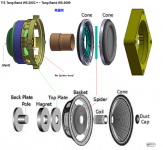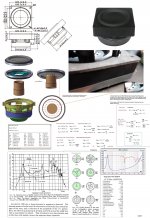Hi,
Has anyone measured Tang Band's claims that their patented RBM woofer designs produce less distortion?
Parts Express are selling the W5 2053 at a discount... and Win ISD says it will work in a tiny 3 or 4 litre box ... can fill in the bottom octave on a low SPL 2.1 system?
From Parts Express:
Tang Band W5-2053 5" RBM Flat Panel Subwoofer 4 Ohm
Tang Band designed their revolutionary RBM (Real Balanced Mode) flat subwoofers for ultra-linear operation, while remaining as thin as possible. The secret to their low distortion performance is in the patented symmetrical suspension system.
While most subwoofers rely upon a spider/surround combination to keep the cone travel linear, Tang Band has developed a new injection molding process that incorporates front and rear cones, as well as dual opposed surrounds.
Similar to an isobaric subwoofer alignment, the two cones work together to modulate a single column of air, reducing non-linear harmonic distortion. The added mass of the rear cone/surround assembly also reduces free air resonance.
Tang Band's W5-2053 5" RBM mini subwoofer features extensive venting on the rear cone, voice coil former, and back plate to keep the large, overhung, neodymium-powered voice coil cool. A bumped back plate allows for momentary moments of over-excursion without damage. Additionally, it offers low distortion frequency response that reaches down to 35 Hz.
Product Specifications
Nominal Diameter5"
Power Handling (RMS)40 Watts
Power Handling (max)80 Watts
Impedance4 ohms
Frequency Response35 to 800 Hz
Sensitivity80 dB 1W/1m
Voice Coil Diameter1.5"
Thiele-Small Parameters
Resonant Frequency (Fs)35 Hz
DC Resistance (Re)3.6 ohms
Voice Coil Inductance (Le)0.19 mH
Mechanical Q (Qms)4.64
Electromagnetic Q (Qes)0.36
Total Q (Qts)0.33
Compliance Equivalent Volume (Vas)0.14 ft.³
BL Product (BL)9.31 Tm
Diaphragm Mass Inc. Airload (Mms)39.92g
Maximum Linear Excursion (Xmax)8 mm
Surface Area of Cone (Sd)75 cm²
Materials of Construction
Cone Material Poly Composite
Surround Material Rubber
Basket / Frame Material Polymer
Magnet Material Ferrite
EDIT the driver finally arrived and here are some pics of the build, which is still a work in progress.
Has anyone measured Tang Band's claims that their patented RBM woofer designs produce less distortion?
An externally hosted image should be here but it was not working when we last tested it.
Parts Express are selling the W5 2053 at a discount... and Win ISD says it will work in a tiny 3 or 4 litre box ... can fill in the bottom octave on a low SPL 2.1 system?
From Parts Express:
Tang Band W5-2053 5" RBM Flat Panel Subwoofer 4 Ohm
Tang Band designed their revolutionary RBM (Real Balanced Mode) flat subwoofers for ultra-linear operation, while remaining as thin as possible. The secret to their low distortion performance is in the patented symmetrical suspension system.
While most subwoofers rely upon a spider/surround combination to keep the cone travel linear, Tang Band has developed a new injection molding process that incorporates front and rear cones, as well as dual opposed surrounds.
Similar to an isobaric subwoofer alignment, the two cones work together to modulate a single column of air, reducing non-linear harmonic distortion. The added mass of the rear cone/surround assembly also reduces free air resonance.
Tang Band's W5-2053 5" RBM mini subwoofer features extensive venting on the rear cone, voice coil former, and back plate to keep the large, overhung, neodymium-powered voice coil cool. A bumped back plate allows for momentary moments of over-excursion without damage. Additionally, it offers low distortion frequency response that reaches down to 35 Hz.
Product Specifications
Nominal Diameter5"
Power Handling (RMS)40 Watts
Power Handling (max)80 Watts
Impedance4 ohms
Frequency Response35 to 800 Hz
Sensitivity80 dB 1W/1m
Voice Coil Diameter1.5"
Thiele-Small Parameters
Resonant Frequency (Fs)35 Hz
DC Resistance (Re)3.6 ohms
Voice Coil Inductance (Le)0.19 mH
Mechanical Q (Qms)4.64
Electromagnetic Q (Qes)0.36
Total Q (Qts)0.33
Compliance Equivalent Volume (Vas)0.14 ft.³
BL Product (BL)9.31 Tm
Diaphragm Mass Inc. Airload (Mms)39.92g
Maximum Linear Excursion (Xmax)8 mm
Surface Area of Cone (Sd)75 cm²
Materials of Construction
Cone Material Poly Composite
Surround Material Rubber
Basket / Frame Material Polymer
Magnet Material Ferrite
EDIT the driver finally arrived and here are some pics of the build, which is still a work in progress.
An externally hosted image should be here but it was not working when we last tested it.
An externally hosted image should be here but it was not working when we last tested it.
An externally hosted image should be here but it was not working when we last tested it.
An externally hosted image should be here but it was not working when we last tested it.
An externally hosted image should be here but it was not working when we last tested it.
Last edited:
Nice to see progress.
With all the huffing and puffing from Klippel, hard to see material change* in design from my 1960 Stephens Trusonic driver to mainstream fancy Rice-Kellogg today?
Anybody think rolled rubber and starched cloth (stretching as the spider stretches in and out) make for a linear spring mechanism?
Very good to see fresh thinking about driver design. At last.
B.
*OK, that's a trick question: you can't "see" an inductance ring on the pole piece
With all the huffing and puffing from Klippel, hard to see material change* in design from my 1960 Stephens Trusonic driver to mainstream fancy Rice-Kellogg today?
Anybody think rolled rubber and starched cloth (stretching as the spider stretches in and out) make for a linear spring mechanism?
Very good to see fresh thinking about driver design. At last.
B.
*OK, that's a trick question: you can't "see" an inductance ring on the pole piece
Pardon my stupidity, but is the only difference between this and a 'normal' driver the additional of another cone and spider behind the usual one?
I am struggling slightly to see any additional differences??
https://www.parts-express.com/pedocs/tech-diagrams/Tang Band Subwoofer Assembly.pdf
I haven't had any caffeine today yet, though, so I might not be functioning on all cylinders...
I am struggling slightly to see any additional differences??
https://www.parts-express.com/pedocs/tech-diagrams/Tang Band Subwoofer Assembly.pdf
I haven't had any caffeine today yet, though, so I might not be functioning on all cylinders...
Hard to tell what's new. But just anything new is new, although there's not much that's actually novel and not actually on some exceptional driver somewhat else except the suspension.Pardon my stupidity, but is the only difference between this and a 'normal' driver the additional of another cone and spider behind the usual one?
But then, really not much matters too much except (1) the linearity of the motor and (2) the linearity of the restorative mechanism (assuming it needs a restorative mechanism aside from a proper two-directional and feedback motor).
Since a corrugated spider is the universal restorative mechanism, sure nice to see ANYTHING new along those lines.
For really new stuff, look at the planar forum, not the sub forum.
B.
Hi All,
FYI:
b
Thanks bjorno!
That's interesting.
It looks like they are relying on the surrounds of each of the cones to be the 'restorative mechanism' that brings the (flat) cone back to the centre point, rather than a spider?
Nothing isobaric except pix. I'd say the similarity is minor.
I see what your saying but I think they argue that there are two cones and the air pressure between those two cones is constant, hence, isobaric.
I've built isobaric driver arrangements so I know from experience as well as the science that they reduce THD. I just don't know how effective this patented design is - so I've bought one to try.
The isobaric concept, as I understand it, uses two identical drivers wired in reverse or mirrored. That way any error introduced in one direction is addressed (cancelled or duplicated?) by the driver in the reverse/mirror mounting. Sort of. There is also the possibly mistaken notion of doubling some parameters by capturing an entrained bit of air.
Here we have a just a single mechanism. The only element connected in reverse is the dual surround that also serves as the total cone suspension, at least as I see the picture. Yes, smart to have the two surrounds mounted in reverse and maybe you get a more linear suspension than using starched fabric (or whatever spiders are made of today).
Yes, there seems to be two "cones". But that may be necessary in order to work properly with the two conventional-looking foam rubber surrounds, eh. I doubt any wee bit of entrained air has any influence.
All I know is the pretty picture and I could be wrong about everything.
B.
Here we have a just a single mechanism. The only element connected in reverse is the dual surround that also serves as the total cone suspension, at least as I see the picture. Yes, smart to have the two surrounds mounted in reverse and maybe you get a more linear suspension than using starched fabric (or whatever spiders are made of today).
Yes, there seems to be two "cones". But that may be necessary in order to work properly with the two conventional-looking foam rubber surrounds, eh. I doubt any wee bit of entrained air has any influence.
All I know is the pretty picture and I could be wrong about everything.
B.
Last edited:
Isobaric cones reduce distortion because the rear cone does the work against the air in the cabinet, like compressing a spring of sorts, but the front does very little due to the isobaric air behind it and a large room of air in front. What the ear hears is the front cone which has much lower distortion, esp at low frequencies and high excursion. I don't know if Tang Band's design fully exploits this because it is one speaker, not an inverse pair, but I see no reason why that front cone won't be having an easier time of it thanks to the rear one. And then, no spider. I can certainly see why they got a patent. But hey, proof of the pudding is in the listening!
Thanks. Here's my updated take on it: only the lower "cone" is attached to the VC. The entrained air motivates the face cone (upper cone) uniformly. Maybe T-B feels that makes the face cone move more accurately (but might have no effect on the sound coming from the lower cone).
B.
B.
- Status
- Not open for further replies.
- Home
- Loudspeakers
- Subwoofers
- Low THD Tang Band RBM drivers?

